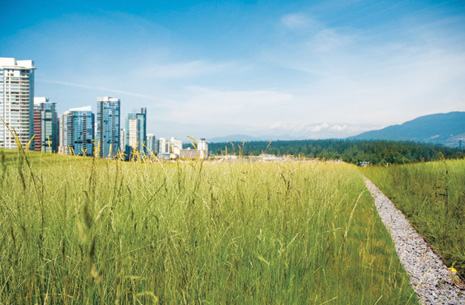Activity: Green Roof Field Trip
 (Adapted from the rain garden curriculum created by the University of Wisconsin, Madison, Arboretum’s Earth Partnership for Schools)
(Adapted from the rain garden curriculum created by the University of Wisconsin, Madison, Arboretum’s Earth Partnership for Schools)
Grade level: Elementary (K – 6)
Group size: 12 – 35
Time needed: 1 to 3 hours
Cost per group: Transportation
Summary: What is a green roof? How do rooftop gardens help protect the environment? In this field-observation activity, elementary students individually or working in teams will learn about green-roof design, energy conservation, and the types of plants and creatures that can live in the extreme environmental conditions found on rooftops. They will identify and describe key engineering features, such as water systems and paths; examine the different types of plants, insects, and animals that inhabit the rooftop ecosystem; and discuss and draw conclusions from their observations.
Learning Objectives
Students will:
- Use their observational skills
- Learn how green roofs are built to save energy
- Describe and sketch different design features and types of plants
- Understand the impact of humans on the landscape
- Draw conclusions from observations
Standards
National Science Education Standards:
- Science as Inquiry (K-8) Develop the abilities necessary to understand scientific concepts; appreciate “how we know” what we know in science; and become independent inquirers about the natural world.
- Science in Personal and Social Perspective (K-8) Abilities of technological design; science and technology in society; populations, resources, and environments.
- Physical Science: Light, heat (K-4); Transfer of Energy (5-8)
- Life Sciences: Organisms and Environment (K-4) Structure and Function in Living Systems; Diversity and Adaptations of Living Systems (5-8)
Green Roof Facts
What’s a green roof? Green roofs are basically plants and gardens on rooftops.
What are the advantages of green roofs?
1 . Cooling
Green roofs can lower temperatures on a roof by 25 – 80 degrees
(on a 90-degree day, a traditional black roof is 170 degrees; a green roof 94 degrees)
Reduces heating and cooling costs by up to 26%
Reduces urban heat island effect
2. Water conservation
Retains up to 75% of water that falls on it
Reduces storm water runoff, improving water quality
Filters pollution so it doesn’t run into storm drains and waterways
3. Benefits of plants
Filter and absorb the pollution from air and water
Reduce carbon dioxide (CO2) thus reducing greenhouse effect
Release oxygen, improving air quality
Reflect solar radiation, cooling surface
4. Wildlife benefits
Provides a habitat and stopping point for migratory birds
Attracts bees and butterflies
Increases biodiversity in urban areas
How are they made?
Top layer: plants, grasses, herbs
2nd layer: mulch or material to prevent erosion
3rd layer: soil
4th layer: drainage layer
5th layer: impervious layer
5th layer: roof structure
Field trip to visit a green roof
Divide the class into 3 groups. Each group will observe a different aspect of the green roof, sketch the roof, label design and plant features from their observations, and discuss and draw conclusions from their observations. Worksheets are downloadable here: Green roof worksheets. The final worksheet is a more general field-observation guide with elements of all three, but more focused on plants and bugs.
Additional Green Roof Resources
For more information about green roofs (including additional lessons), and information about rain gauges, rain gardens and rain barrels check out Green Roof Resources.
Filed under: Class Activities, Grades K-5, Grades K-5, K-12 Outreach Programs








